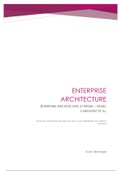Summary
Enterprise Architecture Summary
- Course
- Institution
- Book
This is a summary of the Enterprise Architecture course taught at Utrecht University. This summary extensively summarises the book Enteprrise Architecture at Work by Mark Lankhorst et al. (4th edition) using ArchiMate 3.0. Free pro-tip: Chapter 7 and 10 were not covered in the exam. At all.
[Show more]




